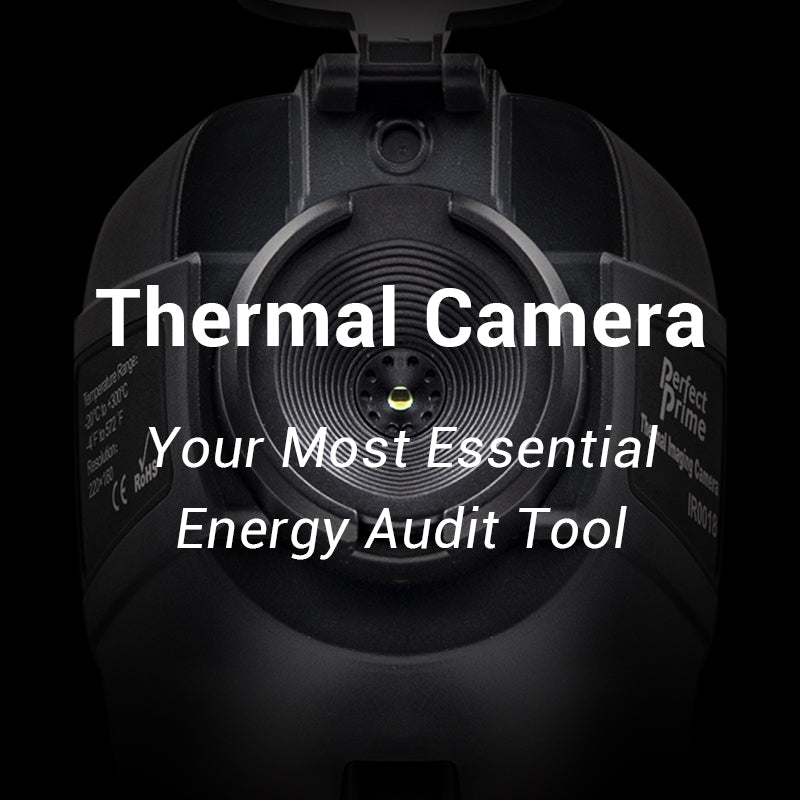Without the benefit of a thermal camera, doing an energy audit is like walking at night blind. You may get to the cold and hot leaks but at what cost. Ultimately, it’s a question of efficiency. Though useful, old-school methods could drag you down, draining key resources in the process. For starters, it will take you longer to locate the problem - if at all. You see, there is no way you can guarantee you’ve kept your end of the bargain. That of putting your client’s comfort to a maximum while keeping energy consumption to a minimum. As you waste time and prove yourself incapable, your reputation slips. In effect, you would have issued a death sentence to a business you love most unnecessarily.
With an infrared camera at your beck and call, you can increase your income stream as an HVAC professional. First stop, it will give you more time to handle more clients. More clients equal greater revenue. Secondly, you get to earn extra dollars from inspections. Add that to your HVAC installation and repair business and you should see an uptick in your financial health. The best part? You ensure customer satisfaction stays at optimal levels. Not to mention keep your clientele out of harm’s way. All because you made a timely decision of going beyond what the human eyes normally see in flushing out hot and cold leaks.

The Case for Energy Audits
Let’s face it, most, if not all, HVAC professionals are proud of their work. And rightly so. However, let’s put some perspective into it. No matter how state-of-the-art the technology put in place and no matter the expertise of the pros on the line, an energy audit should be in order. Why? Simply because that is the only way you can ensure things are running as planned. A quick look back should be telling.
In 2010, National Fire Protection detail there were over 7,400 fires reported in mainland USA. Now that may not raise an eyebrow but this one should. All those fires were traced to faulty AC systems in place. Or in general, faulty HVAC.
Now, you might think surely there were no deaths involved. Well, in that case, you may have to think again. Total damages for all those fires were:
- Over $ 200 million in property damages
- Hundreds of civilians injured
- 29 persons killed.
As an expert, the first thing that comes to your head could be: Was there a chance those fires were preventable? It’s hard to say. But surely, an energy audit a day before those fires would have increased the chances of preventing them.
You might even add, this puts your NFPA 90A air-conditioning installation standard on the spot. But that’s not all the worry. Another fire stat adds up.
From 2012 to 2016, NFPA data show home heating equipment accounts for 15 percent of every home fire that happened in America. Second only to cooking incidents. All these involved over 52,050 fires in that time span. In summary, these were the damages:
- $1 billion in property damages
- 1,400 civilians injured
- 490 deaths
Being a veteran HVAC pro is definitely a great advantage. His trained eye will be able to spot potentially dangerous malfunctions that may not be alarming to an everyday civilian. His nose recognizes the dangers that may lie behind a rotten-egg smell for homeowners. That could be a ‘gas leak’ ready to blow up. Or a burning smell for that matter. These are trouble signs only a work-tested professional can detect at a moment’s notice.
But as best-intentioned and as well-trained you may be on the job, we could be reckless. Yes, habits could betray us.
Again, the Breakwater Apartments fire in New Albany in 2017 should be telling. A veteran HVAC installer found himself pinned down as the root cause of a fire. Definitely, he didn’t deny that the fire was ignited when he did the soldering on a pipe made of copper. No question there. He reasoned he took care of it using two fire extinguishers.
What he didn’t know was that the fire wasn’t contained even when he spent almost an hour putting it out. After he left, the fire took a life all its own and brought down $26.5 million worth of the 206,000-foot apartment. Good thing no lives were lost.
As painful as it is, this incident shows why thermal imaging could be the best thing that ever happened to your business.
Of course, you can choose to keep everything like before. However, truth be told, that could be like burying your head in the sand like an ostrich trying to run away from the problem.

How a Thermal Camera Plug Hot and Cold Leaks
When it comes right down to it, HVAC professionals are like medical doctors. You really don't expect a physician to give you a long list of medicine if he doesn’t even know a thing or two about your ailment.
Same goes true for your heating and cooling business. You really can’t expect to handle something you know nothing about.
This is why spotting hot and cold leaks are essential. Think of it as systemic symptoms. These leaks bring you closer to the root of the problem.
In HVAC as in most everything in life, time is the ultimate test. That applies to your brand new SUV or your new found app. Unfortunately, letting time do the testing for your HVAC business is waiting for a bomb to explode. In as much as hot-and-cold systems today are top of the line, with technologies that could leave the most sophisticated DIY home builder in awe, they do have limitations. When the weeks turn into months and the months into years, chances are a portion or two of the system starts to crack up.
Checking Heat Registers
A quick example is when you verify air flow at various heat registers in an abode. You start by letting the AC or the heat come to life. Putting it on. After 10 minutes or so, you can then put the thermal camera on one hand and run around the house to get the inspection going.
This should be the SOP (standard operating procedure) for new installations.
The resulting images on your infrared camera should give you the potential hotspots in a snap. A radiator not heating up properly will register an anomaly. Part of it is cool and the other part is heated.
An Extra Eye on What’s Underneath an Overhead
Nothing escapes an IR imaging camera. Not even the floors or the ceilings.
With one snap of a finger, you can identify which portion is filled to the brim with heat and which is not. Confirming your suspicions in the process.
For instance, you can determine with certainty which ceiling stains are currently active and which are not. Of course, you can’t use this to define the moisture levels on what’s above. Chances are, however, when it bears the same temperature all throughout, that ceiling is highly unlikely to be wet.
You can even use the camera to check on the glass windows in the house. Usually, escaping gas can cause two glass panes to attract each other - collapsing in the process. The human eye won’t see this. Especially in a clear day. The difference in heat can show you ovals and circles of distinct colors in your IR cam.
Catching Insulation/Electrical Faults
Needless to say, insulation issues makes the IR camera all the more essential. You can easily spot areas in the wall or ceiling where insulation is nonexistent. You can swing the camera to check attic access panels for one.
Uninsulated walls are easily the hottest portion of the wall. So checking color differences should make it all obvious.
Even mouse holes won’t stand a chance of missing the thermal cam’s powerful eyes. You can see how these tiny monsters turn your priced insulation into one swiss cake.
A word on attic rooms. Note that when winter comes knocking, heat in the house moves up to the attic. That’s a normal phenomenon. Careful as cold weather can lead to ice dams. Again, a quick look at the insulation on that part of the house should be spot on.
Turning the cam on the bath fans can show possible faults (e.g., missing exhaust ducts).
Seeing circuit breakers as hot is normal but if things are suspect, you should put an amp meter to good use.
Checking Key Leaks
You can use thermal imaging to look out for water leaks. In this regard, you can observe the movements of a shower dam to check where the water leads. This way, you can test a tiled shower for unwanted leaks.
Fact is a thermal camera can be a lifesaver. You can use the camera to check on the presence of methane gas. Natural gas may be the most efficient fuel but it’s highly combustible when in free air. Not to mention life-threatening. Methane takes out oxygen in a closed space so you won’t be able to breathe.
The good news is thermal cameras can also detect natural gas leaks. The right model of course. We shall be coming out with a more thorough discussion on this for those who want to make the most of IR imaging to detect gas leaks.

How Best to Do an Energy Audit
Different skills, different results. That can be said of scalpels in the hands of trained surgeons and thermal cameras in the hands of HVAC professionals. To do a thorough energy audit with an IR cam requires skill. Below are key areas you need to put your eyes on when doing the rounds:
- Know the time needed for HVAC equipment to reach steady state
- During commissioning, cross-check your duct/coil temp in relation to BAS control nodes
- Check if duct and its piping is compromised
- Estimate ranges of operating temp for your process air and respective fluids
- Detect leaks in fluid and air indirectly
- Know which coils are operational and which are problematic
- Spot blown fuses and possible circuit disturbances
- Check firsthand if the condenser is plugged or if it lacks cooling
This topic sure needs a lot more input. Again, we shall provide a more thorough discussion on this.
One thing is certain you need to make sure your HVAC systems are turned on before you snap that thermal camera into action. And if things don’t really work best, using a blower door should get you a most optimized energy audit. Catching those hot and cold leaks red-handed.
Check out our thermal camera range today from our own cost-effective brand PerfectPrime to our partner Seek products: https://perfectprime.com/pages/thermal-imaging-camera

